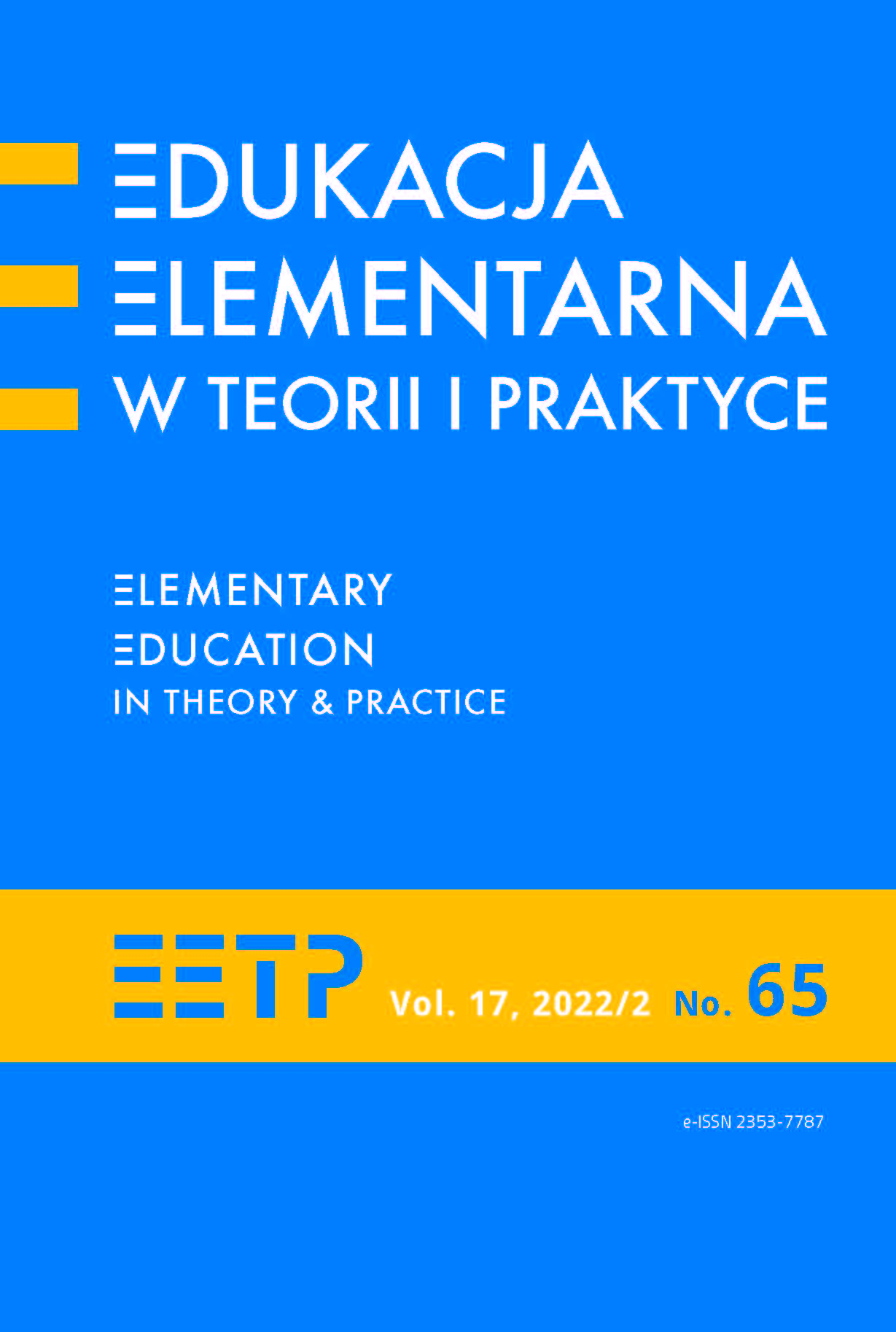Wspomaganie procesu obserwacji i tworzenia rysunku brył przez dzieci w wieku 6-9 lat- wybrane problemy
Abstrakt
Z uwagi na znaczenie działań aktywizujących i kształcących zmysł obserwacji dla czynności uczenia się u dzieci, za cel badawczy o charakterze poznawczym przyjęto ustalenie istotności czynnika podkreślającego konstrukcję obserwowanych brył dla tworzonych przez dzieci ich graficznych schematów, w tym ukazywania trzeciego wymiaru. Przyjętym problemem reprezentującym ogólny aspekt obszaru badawczego stało się pytanie o znaczenie nowego czynnika, jakim jest linia wyróżniająca krawędzie brył, dla sposobu przedstawiania za pomocą rysunku obserwowanych przez dzieci brył geometrycznych. Założono, że dla przebiegu zachodzących zmian w rozwoju rysunków brył będzie można wyznaczyć charakterystyczne etapy-schematy oraz czynnik wzmacniający proces obserwacji konstrukcji brył. Analiza zebranych danych pozwoliła zauważyć, że wprowadzony czynnik ma istotne znaczenie dla poziomu umiejętności graficznego zapisu brył geometrycznych, co może przekładać się na kształcenie zmysłu przestrzennego u dzieci. W oparciu o prowadzoną analizę porównawczą prac plastycznych powstających w sytuacji rysowania bezpośrednio obserwowanych przez dzieci zróżnicowanych białych brył (w wersjach o krawędziach zaznaczonych czarną linią i bez niej), uzyskana wiedza może zostać wykorzystana w procesie projektowania zadań edukacyjnych oraz pomocy dydaktycznych, dla których istotne jest doskonalenie percepcji wzrokowej obejmującej również trzeci wymiar rzeczywistości.
Bibliografia
Arnheim R. (1978). Sztuka i percepcja wzrokowa, Warszawa: Wydawnictwa Artystyczne i Filmowe.
Caron-Pargue J. (1979). Etude sur les representations du cube chez des enfants de 3 á 11 ans, Paryż: V University.
Chmielnicka-Plaskota A. (2014). Rysunek dziecka. Badania porównawcze Polska–USA. Warszawa: Difin.
Józefowski E., J. Florczykiewicz (2015). Warsztat twórczy jako okazja rozwoju podmiotowego w przestrzeni sztuki, Wrocław: JAKS.
Limont W. (1996). Analiza wybranych mechanizmów wyobraźni twórczej. Badania eksperymentalne, Toruń: Wydawnictwo Uniwersytetu Mikołaja Kopernika.
Łapot-Dzierwa K. (2018). Techniki plastyczne w pracy z dziećmi, Kraków: CEBP.
Nęcka E. (2005). Psychologia twórczości, Gdańsk: Gdańskie Wydawnictwo Psychologiczne.
Piwowarska E. (2019). Poznawanie i rysowanie brył przez dzieci 3–9-letnich – ujęcie procesualne i edukacyjne, Częstochowa: Uniwersytet Humanistyczno-Przyrodniczy im. Jana Długosza.
Piwowarska E. (2021). Przygotowanie do zawodu nauczyciela edukacji wczesnoszkolnej w kontekście uzdolnień i umiejętności graficznego ukazywania brył – wybrane zagadnienia, „Konteksty Pedagogiczne”, nr 2 (17), s. 147–158.
Słownik psychologiczny. (1985). red. W. Szewczuk, Warszawa: Wiedza Powszechna.
Słownik wyrazów obcych. (1980). red. J. Tokarski, Warszawa: PWN.
Spionek H. (1965). Zaburzenia psychoruchowego rozwoju dziecka, Warszawa: PWN.
Szempruch J. (2001). Nauczyciel w zmieniającej się szkole. Funkcjonowanie i rozwój zawodowy, Rzeszów: Wydawnictwo Oświatowe FOSZE.
Wojnar I. (1976). Teoria wychowania estetycznego, Warszawa: PWN.
Magnan A. i Juan de Mendoz J.-L. (1990). L’apprentissage de la Representation Graphique du Cube chez des Enfants de 6–7 ans, „L’annèe Psychologique”, t. 90, nr 3, s. 320–344, http://www.persee.fr/doc/psy_0003-5033_1990_num_90_3_29409 [dostęp: 2022.01.13]
Nicholls A. L., Kennedy J. M. (1992). Drawing Development: From Similarity of Features to Direction, „Child Development”, t. 63, nr 1, s. 227–241, https://www.jstor.org/stable/1130915 [dostęp: 14.01.2022].
Podstawa programowa. I etap edukacyjny: klasy I–III – edukacja wczesnoszkolna. (2017) Rozporządzenie Ministra Edukacji Narodowej, D.U., poz. 356, http://isap.sejm.gov.pl/isap.nsf/download.xsp/WDU20170000356/O/D20170356.pdf [dostęp: 06.03.2022].
Copyright (c) 2022 Edukacja Elementarna w Teorii i Praktyce

Utwór dostępny jest na licencji Creative Commons Uznanie autorstwa – Bez utworów zależnych 4.0 Międzynarodowe.
1. Autor zgłaszając swój artykuł oświadcza, że jest Autorem artykułu (zwanego dalej Utworem) i:
- przysługują mu wyłączne i nieograniczone prawa autorskie do Utworu,
- jest uprawniony/a do rozporządzania prawami autorskimi do Utworu.
Oświadcza, że nie narusza praw autorskich osób trzecich i praw prawnych.
Oświadcza, że nie występuje żaden konflikt interesów.
2. Udziela Uniwersytetowi Ignatianum w Krakowie nieodpłatnej, niewyłącznej, nieograniczonej terytorialnie licencji do korzystania z Utworu na następujących polach eksploatacji:
- utrwalania utworu w formie papierowej, a także na nośniku cyfrowym lub magnetycznym;
- zwielokrotnienia utworu dowolną techniką, bez ograniczenia ilości wydań i liczby egzemplarzy;
- rozpowszechniania utworu i jego zwielokrotnionych egzemplarzy na jakimkolwiek nośniku, w tym wprowadzenia do obrotu, sprzedaży, użyczenia, najmu;
- wprowadzenia utworu do pamięci komputera;
- rozpowszechniania utworu w sieciach informatycznych, w tym w sieci Internet;
- publicznego wykonania, wystawienia, wyświetlenia, odtworzenia oraz nadawania i reemitowania, a także publicznego udostępniania utworu w taki sposób, aby każdy mógł mieć do niego dostęp w miejscu i czasie przez siebie wybranym;
- w zakresie praw zależnych do Utworu, obejmujących w szczególności prawo do dokonania koniecznych zmian w Utworze, wynikających z opracowania redakcyjnego i metodycznego, a także do dokonania tłumaczenia Utworu na języki obce.
Udzielenie licencji następuje z chwilą przekazania Utworu na rzecz Uniwersytetowi Ignatianum w Krakowie. Uniwersytet Ignatianum w Krakowie jest uprawniony do udzielania dalszych sublicencji do Utworu, w zakresie udzielonego prawa. Licencja jest ograniczona czasowo i zostaje udzielona na okres 15 lat, licząc od daty jej udzielenia.
Wyraża się zgodę i zachęca autorów do publikacji ich tekstu w Internecie (np. w repozytorium instytucji lub na jej stronie internetowej) przed lub podczas procesu składania tekstu jako, że może to prowadzić do korzystnych wymian oraz wcześniejszego i większego cytowania opublikowanego tekstu (Patrz The Effect of Open Access). Zalecamy wykorzystanie dowolnego portalu stowarzyszeń badawczych z niżej wymienionych:




